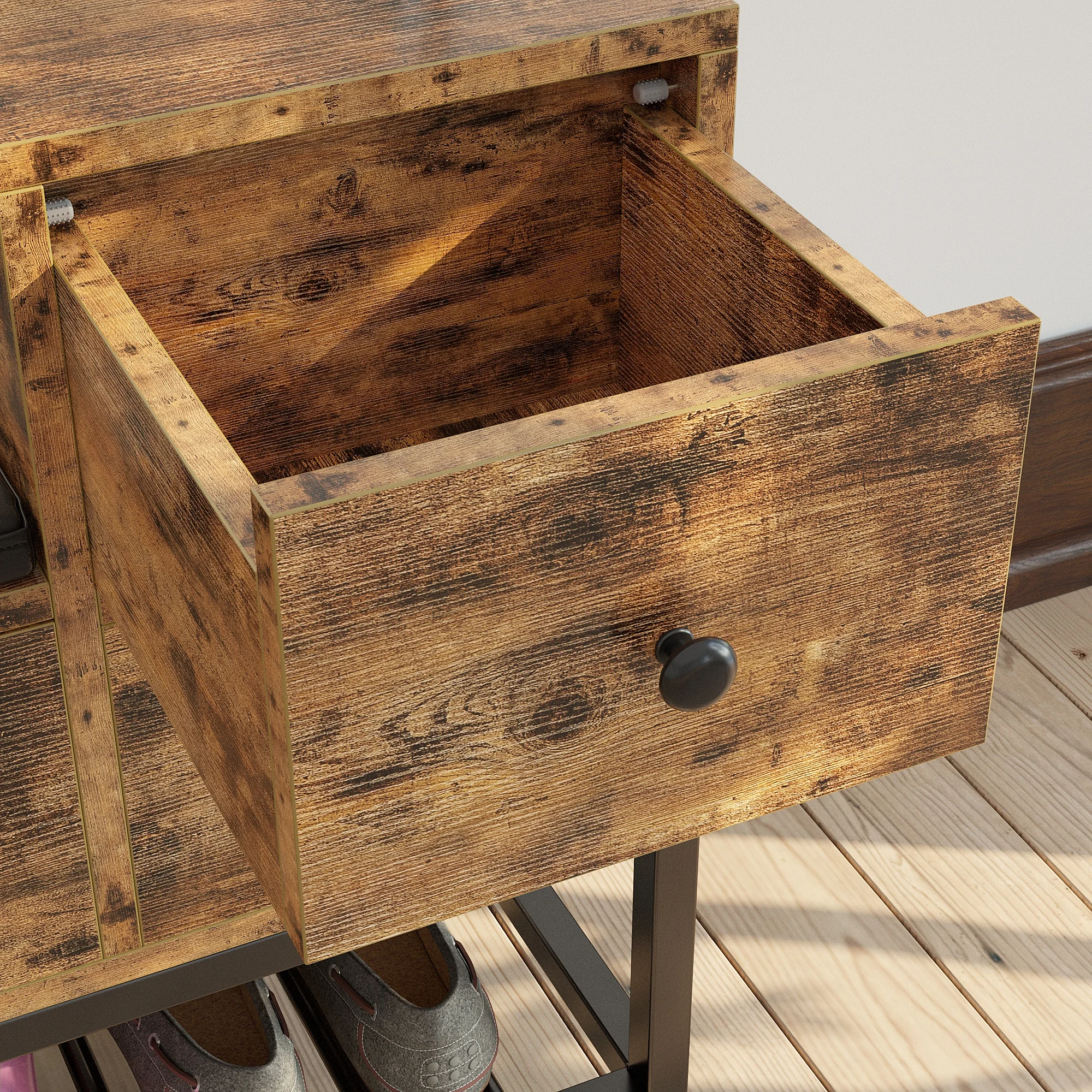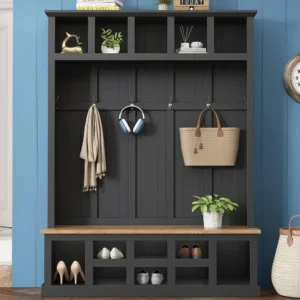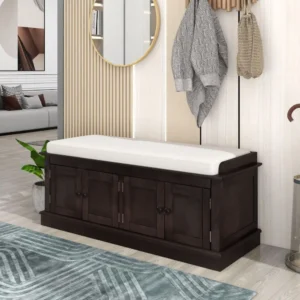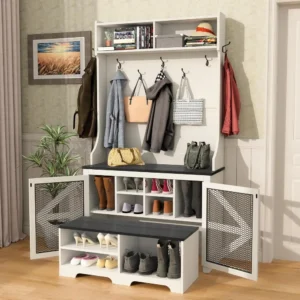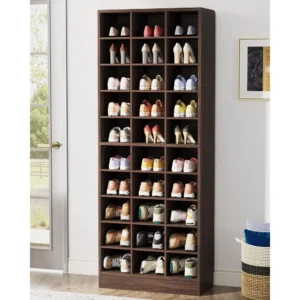Why Every Family Home Needs an Entryway Bench with Storage for Kids’ Items
Walking into a family home often means navigating through a sea of backpacks, shoes, sports equipment, and seasonal gear that seems to multiply overnight. The average school-aged child brings home approximately 10-15 items daily that need a designated spot in your entryway – from shoes and coats to homework folders and sports equipment. This daily avalanche of belongings can quickly transform an otherwise welcoming entrance into a cluttered, stress-inducing space.
An entryway bench with storage designed specifically for kids’ gear offers an elegant solution to this universal challenge. These multi-functional pieces serve as both practical organizers and comfortable seating areas where children can independently manage their belongings.
Key benefits include:
- Creating designated homes for everyday items, reducing morning searches for missing shoes or gloves
- Maximizing vertical and horizontal space in typically small entryway areas
- Teaching children responsibility through accessible organization systems
- Providing a convenient spot for putting on and removing shoes and outerwear
- Reducing dirt and clutter spread throughout your home
Space-saving benches have transformed countless family entryways from chaotic dumping grounds into functional, organized transition spaces. The right storage bench serves as both a beautiful furniture piece and a practical command center for managing the constant flow of kids’ belongings.
Essential Features to Consider When Choosing a Kid-Friendly Entryway Storage Bench
Safety and Child-Appropriate Design Elements
When selecting an entryway bench for kids, safety should be your first priority. The ideal height for children to use independently typically ranges from 12-18 inches from the floor to the seating surface, depending on your children’s ages. Young children benefit from lower heights (12-14 inches), while older kids can comfortably use benches up to 18 inches tall.
Beyond height, look for:
- Rounded corners and edges to prevent injuries during active play
- Sturdy construction that won’t tip even when climbed on
- Non-toxic finishes free from harmful chemicals
- Smooth surfaces without splinters or rough spots
Understanding the perfect entryway bench height for your family’s specific needs ensures both comfort and safety. Remember that children grow quickly, so a slightly taller bench with a step stool might provide more long-term value than a very low option.
Storage Configurations for Different Types of Kids’ Gear
Different storage designs excel at organizing specific types of children’s items. Consider what your family needs to store most frequently when choosing your configuration:
Open cubbies offer excellent visibility and accessibility, making them ideal for young children who are developing independence. They work wonderfully for shoes, backpacks, and items used daily. However, they do keep everything visible, which some may find visually busy.
Closed storage compartments help contain visual clutter and are perfect for seasonal items or belongings that don’t need daily access. They typically require more motor skills to operate, making them better suited for older children.
For most families, a combination of mudroom bench cubbies with some enclosed storage provides the ideal balance. This setup allows frequently used items to remain accessible while keeping less-used belongings neatly tucked away.
Size and Space Requirements
Before purchasing, carefully measure your entryway space, considering both the footprint and how the bench will affect traffic flow. A good rule of thumb:
- Small entryways (under 4 feet wide): Consider narrow benches 30-36 inches wide
- Medium entryways (4-6 feet): Standard benches 36-48 inches wide work well
- Large entryways (over 6 feet): Extended benches or L-shaped configurations can maximize storage
Remember to leave at least 36 inches of clearance in walking paths to maintain comfortable traffic flow. For families with limited square footage, small entryway bench organization strategies can help maximize efficiency even in tight spaces.
Durability and Maintenance Factors
Children can be tough on furniture, so investing in durable construction will save money and frustration long-term. Look for:
- Solid wood construction or high-quality engineered wood with reinforced joints
- Water-resistant finishes that can handle wet boots and umbrellas
- Scratch-resistant surfaces that withstand daily use
- Easily cleanable materials—smooth surfaces are typically easier to wipe down
The best kid-friendly benches balance aesthetic appeal with practical durability, ensuring they’ll continue looking good despite years of active use.
Types of Entryway Benches Specifically Designed for Children’s Items
Cubby-Style Benches
Cubby-style benches feature open compartments that provide clear visibility and easy access to stored items. These benches work especially well for families with young children who are still developing organizational habits, as the open design makes it immediately obvious where items belong.
Key advantages include:
- Visual organization that helps children see where to place belongings
- Quick access without needing to open doors or drawers
- Customizable spaces that work well with storage bins for smaller items
- Simple design that’s appropriate for children as young as toddlers
Shoe cubby benches are particularly popular for families, as they combine seating with specific compartments sized for children’s footwear. This design helps establish the habit of removing and storing shoes immediately upon entering.
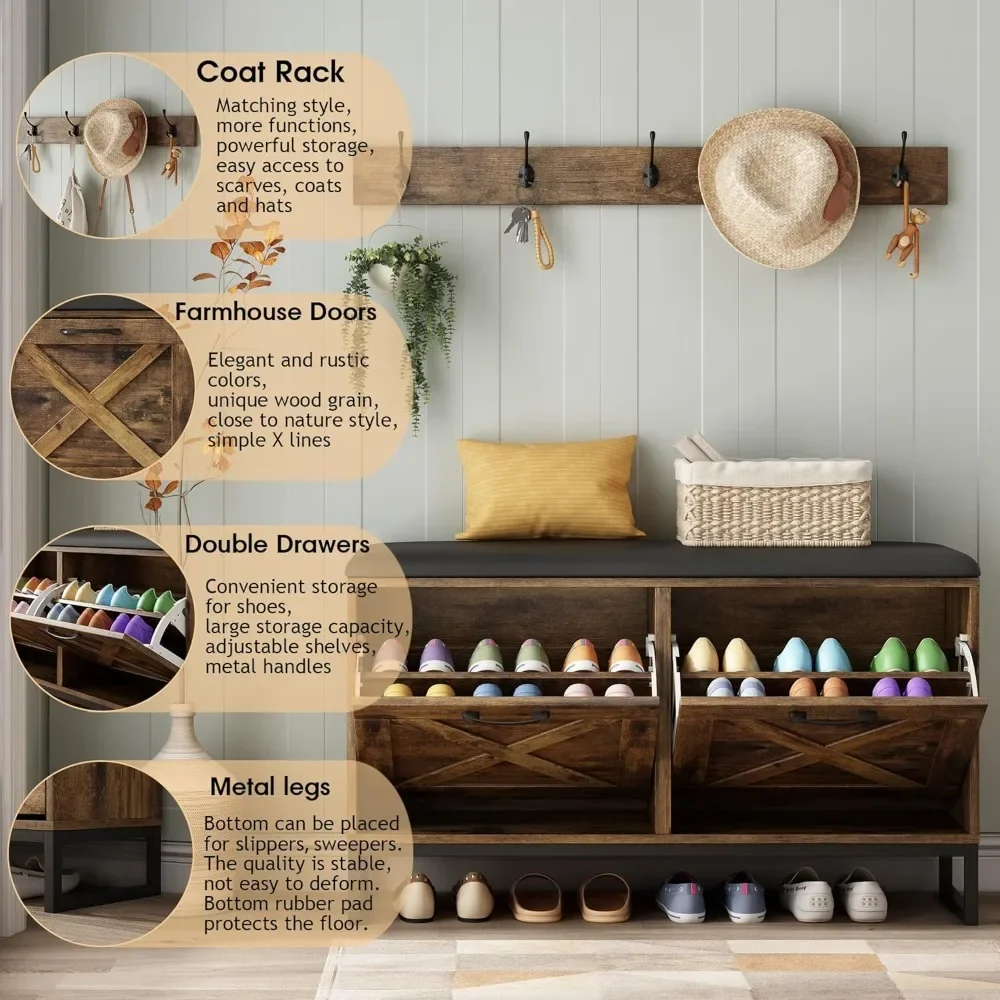
Lift-Top Storage Benches
Lift-top benches feature hidden storage beneath a hinged seat, creating a clean, uncluttered appearance in your entryway. This design excels at containing visual mess while still providing substantial storage capacity.
Benefits include:
- Large, spacious interior for bulky items like sports equipment
- Clean aesthetic that conceals clutter
- Often includes upholstered seating for comfort
- Works well for storing seasonal items like winter gear
For safety, look for models with soft-close hinges or safety stops to prevent pinched fingers. Most shoe benches with cushions provide both comfort and practical storage while maintaining a polished appearance.
Hall Tree Combination Units
Hall tree combinations merge vertical and horizontal storage by combining a bench with overhead hooks and sometimes shelving or cabinets. This comprehensive design maximizes space utilization by building upward rather than outward.
Advantages include:
- Complete organization system in one piece of furniture
- Dedicated hooks for backpacks, coats, and bags
- Mirror options for last-minute appearance checks
- Efficient use of vertical space in smaller homes
These entryway hall trees work particularly well for school-aged children who need to hang backpacks and coats at accessible heights. The all-in-one design helps contain clutter to a single area rather than spreading throughout your entryway.
Drawer and Cabinet Benches
Drawer and cabinet benches offer enclosed storage beneath the seating surface, concealing items behind doors or within pull-out drawers. This design provides the cleanest appearance while still maintaining substantial storage capacity.
Key benefits include:
- Concealed storage that maintains a tidy aesthetic
- Protection for items that shouldn’t be exposed to dust
- Designated spaces for different categories of belongings
- Secure storage for items that shouldn’t be immediately accessible to very young children
Entryway benches with drawers work particularly well for families with older children who can manage opening and closing drawers independently. They’re also excellent for homes where aesthetic considerations are a high priority.
Material Selection for Durability and Child Safety
The material of your entryway bench significantly impacts its durability, safety, and maintenance requirements—all crucial factors for furniture used by children. Here’s how common materials compare:
Solid Wood
* Durability: Excellent longevity with proper care; can withstand decades of use
* Safety: Natural, non-toxic material when properly finished
* Maintenance: Requires occasional polishing and protection from excessive moisture
* Aesthetics: Warm, timeless appearance that ages beautifully
* Cost: Higher initial investment but excellent long-term value
Engineered Wood
* Durability: Good resistance to warping but may not withstand rough handling as well as solid wood
* Safety: Look for CARB-compliant products to ensure low formaldehyde emissions
* Maintenance: Easy to clean but may require more careful handling to prevent damage
* Aesthetics: Available in various finishes and styles
* Cost: More affordable than solid wood options
Metal Combinations
* Durability: Excellent strength and stability when properly constructed
* Safety: No splintering concerns but monitor for sharp edges
* Maintenance: Resistant to moisture but may show scratches
* Aesthetics: Contemporary, industrial appeal
* Cost: Moderate, depending on quality
Upholstered Elements
* Durability: Varies significantly by fabric; look for performance fabrics with high rub counts
* Safety: Choose washable materials for homes with young children
* Maintenance: May require regular cleaning, especially in high-traffic areas
* Aesthetics: Adds comfort and softness to the entryway
* Cost: Variable depending on fabric quality
For families with young children, solid wood or metal-wood combinations generally offer the best balance of durability and safety. Innovative space-saving entryway ideas often incorporate clever material combinations that maximize functionality without compromising durability.
Top Entryway Storage Bench Configurations for Different Family Needs
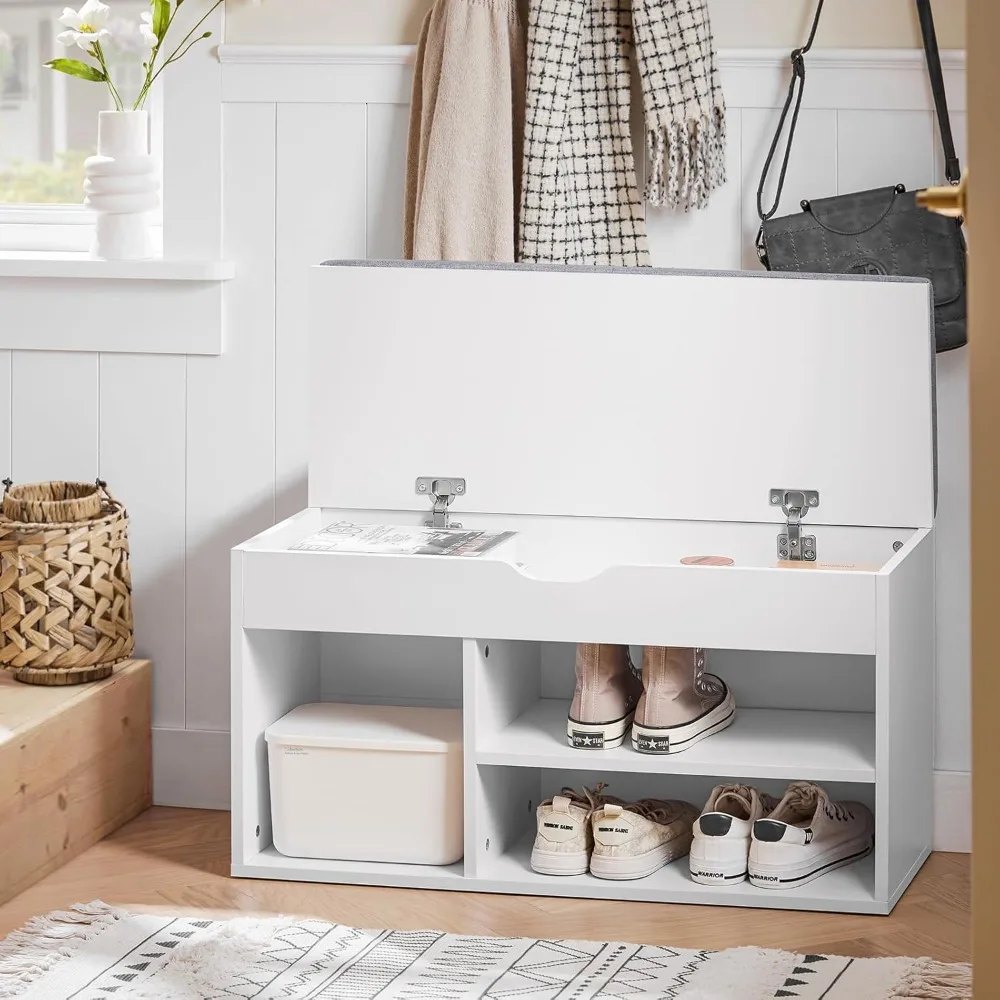
Best Configurations for Preschool-Aged Children
Preschoolers are developing independence but still need intuitive, accessible storage systems. Ideal configurations include:
- Lower bench heights (12-14 inches) that allow feet to touch the floor when seated
- Open cubbies that clearly show where items belong
- Picture labels rather than text for non-readers
- Simplified organization with fewer, larger compartments
- Rounded edges and soft-close features for safety
Look for entry benches with shoe storage that feature open compartments sized appropriately for small footwear. The best options for this age group emphasize accessibility and visual organization over complex sorting systems.
Optimal Solutions for School-Aged Children
School-aged children manage more belongings and can handle more sophisticated organization systems. Effective configurations include:
- Standard bench heights (14-18 inches)
- Combination of open cubbies for daily items and closed storage for occasional use
- Hooks at accessible heights for backpacks and coats
- Designated spaces for homework folders and school projects
- Combination of shared and individual storage zones
School-aged children benefit from having clearly assigned spaces for their belongings, which helps teach responsibility while maintaining organization.
Space-Saving Options for Small Entryways
Limited entryway space requires creative solutions that maximize functionality without overcrowding. Consider:
- Corner bench configurations that utilize otherwise wasted space
- Vertical storage that builds upward rather than outward
- Wall-mounted components that free up floor space
- Multi-functional pieces that serve several purposes
- Modular components that can be reconfigured as needed
Space-saving entry benches for small homes focus on efficient design that maximizes storage capacity while minimizing footprint, ensuring even compact entryways remain functional and organized.
Large Family Organization Systems
Families with multiple children need robust systems that can accommodate everyone’s belongings without creating chaos. Effective solutions include:
- Extended bench configurations with 4+ cubbies or compartments
- Color-coded or labeled zones for each family member
- Combination of low and high storage to accommodate different ages
- Heavy-duty construction that withstands increased use
- Expandable or modular systems that can grow with your family
The key to success with larger families is creating clearly defined zones for each child while maintaining a cohesive overall system.
Bench with Hooks and Storage, Entryway Hall Tree, Mudroom Bench with Cubbies, Mudroom Bench with Shoe Storage
$818.38 Select options This product has multiple variants. The options may be chosen on the product pageEntryway Coat Rack Bench, Entryway Hall Tree, Farmhouse Mudroom Bench, Mudroom Bench with Shoe Storage
$805.09 Select options This product has multiple variants. The options may be chosen on the product pageEntryway Bench with Cushion, Mudroom Bench with Cabinets, Shoe Bench for Entryway, Shoe Bench with Cushion
$991.71 Select options This product has multiple variants. The options may be chosen on the product pageBench with Hooks and Storage, Entryway Coat Rack Bench, Entryway Hall Tree, Mudroom Bench with Shoe Storage, Mudroom Coat Rack Bench
$793.73 Select options This product has multiple variants. The options may be chosen on the product pageShoe Bench for Entryway, Shoe Cubby Bench
Price range: $514.96 through $526.05 Select options This product has multiple variants. The options may be chosen on the product pageCoat Rack Shoe Bench, Entryway Coat Rack Bench, Entryway Hall Tree, Wood Entryway Bench
$479.82 Select options This product has multiple variants. The options may be chosen on the product page
Creating an Effective Organization System with Your Entryway Bench
Even the most well-designed entryway bench won’t maintain order without an intentional organization system. Follow these steps to create a sustainable solution for your family:
Analyze your family’s specific needs
* Take inventory of what regularly enters your home
* Note which items cause the most clutter or get lost most frequently
* Consider each family member’s habits and challengesEstablish clear zones for different categories
* Designate specific areas for shoes, outerwear, backpacks, and accessories
* Create separate sections for each family member if space permits
* Consider seasonal needs and how zones might change throughout the yearImplement visual guides for young children
* Use picture labels for pre-readers
* Consider color-coding for different family members
* Demonstrate the system repeatedly until habits formCreate supporting routines
* Establish a “coming home” sequence that includes putting items in their places
* Build a morning routine that incorporates grabbing necessary items
* Schedule regular quick clean-ups to maintain the systemAdapt seasonally
* Rotate seasonal gear to front-facing, accessible storage
* Store off-season items in less accessible compartments
* Reassess the system quarterly to ensure it still meets your family’s needs
Best small benches for entryways can be particularly effective when paired with a thoughtful organization system, proving that even compact solutions can provide substantial functionality when properly utilized.
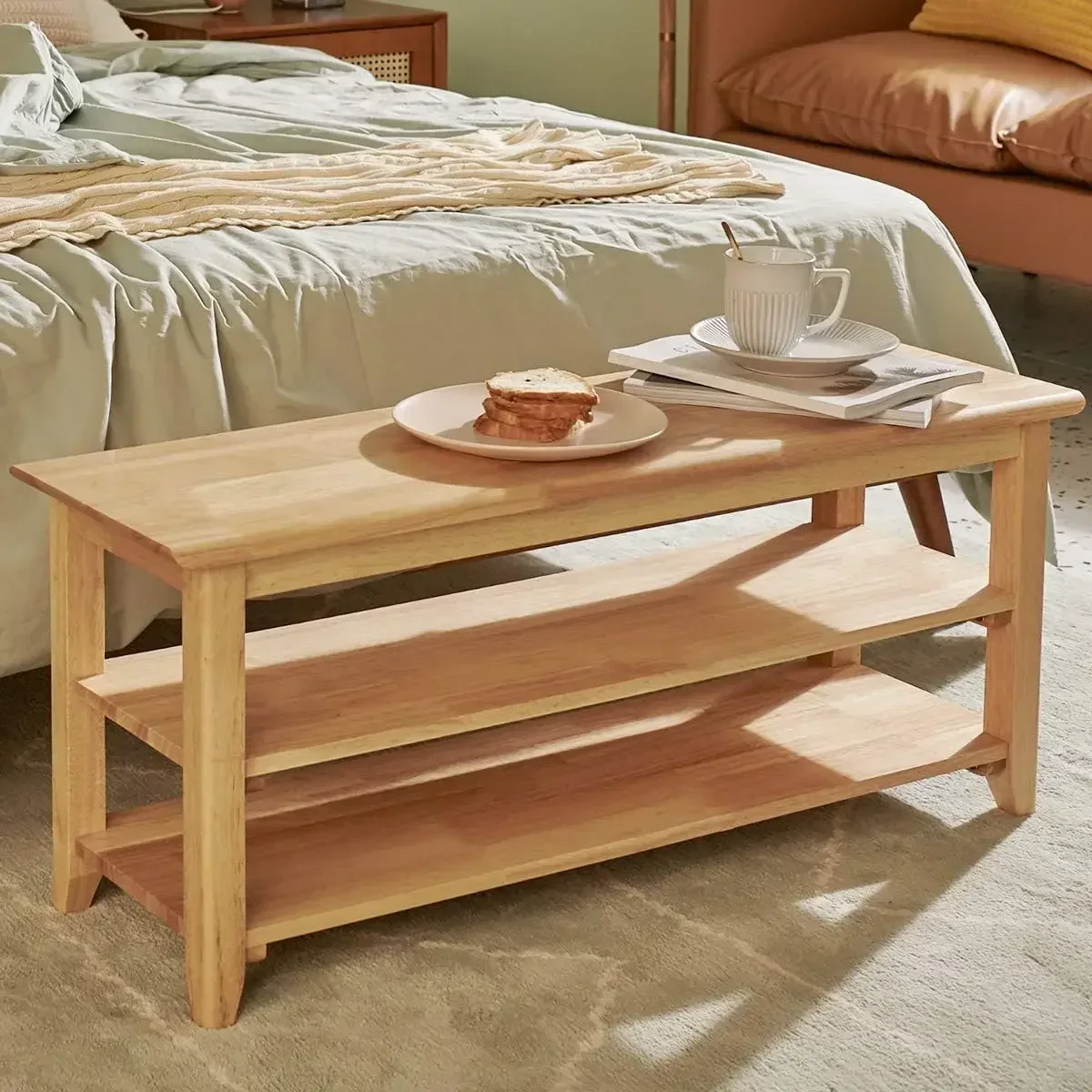
Placement and Installation Considerations
The effectiveness of your entryway bench depends significantly on its placement and installation. Consider these guidelines when determining the optimal location:
- Position the bench perpendicular to the most frequently used entrance when space allows
- Maintain at least 36 inches of clearance for walking paths
- Consider natural light sources—placing a bench under a window creates a pleasant seating area
- Avoid blocking heating vents or air returns
- For security, keep bench placement away from windows visible from outside
For installation, most benches require basic assembly with standard household tools:
* Screwdriver (typically Phillips head)
* Allen wrench (often included with the product)
* Level for ensuring straight installation
* Stud finder if wall-mounting is required
Taller hall tree units should be anchored to the wall for safety, especially in homes with young children. This simple precaution prevents tipping accidents when children climb or pull on the furniture.
Maximizing small spaces with smart entryway benches often involves creative placement solutions that consider both traffic flow and functionality. Even compact areas can accommodate effective organization systems when thoughtfully arranged.
Frequently Asked Questions About Entryway Benches for Kids’ Gear
What’s the ideal height for a children’s entryway bench?
The ideal seating height ranges from 12-18 inches depending on your children’s ages. For preschoolers, aim for 12-14 inches to allow their feet to touch the floor comfortably. For school-aged children, 14-18 inches is typically appropriate. If purchasing for long-term use, choosing a slightly taller bench with a small step stool provides flexibility as children grow.
How can I prevent my children’s entryway bench from becoming cluttered?
Implement a “one in, one out” policy where new items entering must replace existing items. Schedule weekly quick clean-ups to reset the system, and involve children in the process to build good habits. Consider seasonal rotations to keep only current items in prime positions.
Are entryway benches with cushions practical for kids?
Cushioned benches can work well with the right fabric selection. Look for performance fabrics with high durability ratings and stain resistance. Removable, washable cushion covers are ideal for families with young children. Darker colors or patterns will hide inevitable marks better than light solids.
How do I maintain and clean an entryway bench used by children?
Develop a routine of daily quick wipe-downs with a slightly damp cloth for high-touch surfaces. For deeper cleaning, use gentle cleaners appropriate for your bench’s material. Vacuum cushions and crevices weekly to prevent dirt buildup, and consider applying protective treatments to wood surfaces annually.
Can an adult-sized entryway bench work for children?
Standard-height benches (approximately 18 inches) can work for school-aged children but may be challenging for preschoolers to use independently. Consider adding a small step stool to help younger children access higher seating. Top-rated entry benches with storage hooks often come in various heights to accommodate different family needs.
Supplementary Organization Tools to Enhance Your Entryway Bench
While an entryway bench forms the foundation of your organization system, complementary accessories can significantly enhance functionality:
- Wall-mounted key hooks positioned at adult height keep important items secure
- Labeled bins or baskets within cubbies corral smaller items like gloves and hats
- Boot trays beneath or beside the bench contain dirt and moisture
- Wall-mounted mail organizers keep papers from cluttering the bench surface
- Over-the-door organizers on nearby closet doors provide additional storage without consuming floor space
For seasonal considerations, rotating storage solutions help manage bulky winter gear or summer sports equipment. Vacuum storage bags can compress off-season items, while specialized organizers like umbrella stands become more valuable during rainy seasons.
For tech-savvy families, consider incorporating charging stations into your entryway system to keep devices organized and powered. Some modern entryway benches even include built-in USB ports for convenient charging.
By thoughtfully combining your entryway bench with complementary organization tools, you can create a comprehensive system that handles everything from tiny hair accessories to bulky sports equipment, ensuring your family’s entrance remains functional, organized, and welcoming year-round.

